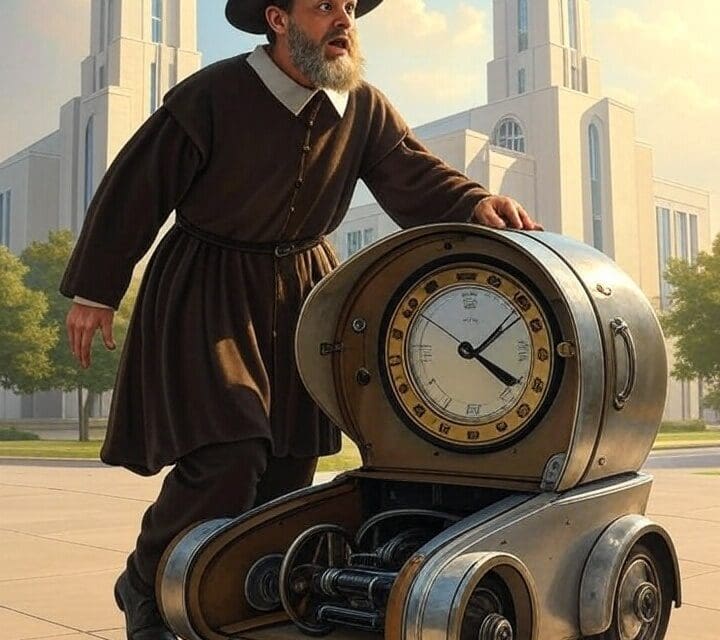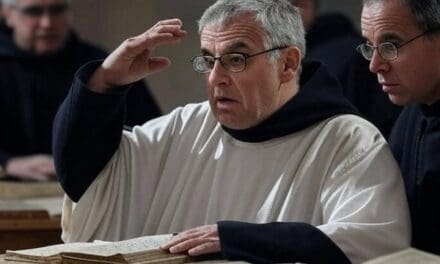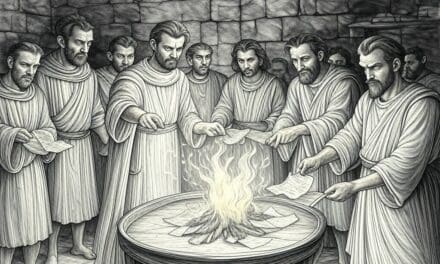Imagine a Christian from the 1st century, stepping from the vibrant, Spirit-filled gatherings of Jerusalem or Corinth (circa 50–100 CE) into 2025, seeking the true church of Jesus Christ. They would yearn for the divine blueprint of the New Testament: apostles guiding with divine authority, heavens ablaze with ongoing revelation, an open canon enriched with new scripture, temple worship radiant with sanctity, a unified global church, and a profound understanding of God the Father and Jesus Christ as distinct, divine beings in a literal Father-Son relationship, with humanity as God’s offspring, destined for theosis. They would also carry apostolic warnings of a Great Apostasy, a catastrophic loss of truth foretold by Paul (2 Thessalonians 2:3, Acts 20:29–30) and John (Revelation 13), alongside the radiant promise of a restoration to revive Christ’s church (Daniel 2:44, Acts 3:21). The Church of Jesus Christ of Latter-day Saints (LDS Church) shines as the unmistakable home they would recognize, while traditional churches—Roman Catholic, Eastern Orthodox, Protestant, and evangelical—would appear as apostate shadows, mired in error.
What a 1st-Century Christian Would Expect from Christ’s Church
Rooted in the New Testament (Acts, Epistles, Revelation) and early writings like the Didache, a 1st-century Christian would seek a church with:
- Apostles: Leaders like Peter or Paul, called by Christ to teach, reveal God’s will, and resolve disputes with divine authority (Matthew 16:18–19, Acts 15:2).
- Ongoing Revelation: Public revelation through apostles and prophets, as seen in Peter’s visions or the Spirit’s guidance (Acts 10:9–16, 13:2).
- Open Canon: New inspired writings, like Paul’s epistles or Revelation, alongside the Hebrew Scriptures (2 Peter 3:16), open to further divine words.
- Temple Worship: Jewish Christians revered the Jerusalem Temple for prayer (Acts 3:1), though worship thrived in homes, with believers as the “temple” of the Spirit (1 Corinthians 3:16). Temple practices could evolve under apostolic direction.
- Unity: A single, unified church, free of factions, as urged in 1 Corinthians 1:10 and Ephesians 4:4–6.
- God, Jesus, and Theosis: God as the literal Father, Jesus as His divine Son, distinct in their roles (John 17:3, 14:28). Jesus’ declaration, “My Father and your Father, my God and your God” (John 20:17), affirmed God as the Father of all, with humanity as His offspring (Acts 17:29), destined for theosis—becoming “partakers of the divine nature” (2 Peter 1:4), inheriting all God has as “joint-heirs with Christ” (Romans 8:17), gods in embryo, of the same divine species.
- Worship and Community: Home gatherings with the Eucharist, believer’s baptism by immersion, prayer, and singing (Acts 2:42–46), marked by shared possessions, evangelism, and endurance amid persecution (Acts 4:32–35, 8:1).
- Apostasy and Restoration: A falling away, as Paul warned of “grievous wolves” and a “falling away” (Acts 20:29–30, 2 Thessalonians 2:3), with truth and authority lost, but a restoration to renew Christ’s church, as foretold in Daniel’s everlasting kingdom (Daniel 2:44) and Peter’s “restitution of all things” (Acts 3:21).
Later developments—cessation of apostles, the Nicene Creed, the Trinity’s one-substance doctrine, a closed canon, and denominationalism—would appear as stark evidence of apostasy, alien to Christ’s teachings.
The Church They Would Recognize: The LDS Church
The LDS Church, as the divinely restored church of Jesus Christ, stands as the triumphant fulfillment of the 1st-century church’s practices and the prophesied restoration, a beacon a time-traveling Christian would embrace with exultation.
Apostles and Revelation
Guided by the President of the Church, sustained as the Prophet, seer, and revelator, and the Quorum of the Twelve Apostles, all sustained as prophets, seers, and revelators, the LDS Church mirrors the leadership of Peter and Paul (Acts 15:28). This apostolic authority, flowing through open heavens, would captivate a 1st-century Christian, confirming the restoration of Christ’s church after the apostasy’s darkness (Ephesians 2:20).
Open Canon and Ongoing Scripture
The LDS Church’s embrace of new scriptures—the Book of Mormon, Doctrine and Covenants, and Pearl of Great Price—reflects the early church’s openness to Paul’s letters or John’s Revelation. A 1st-century Christian would see the Book of Mormon’s testimony of Christ as a divine outpouring, a hallmark of the restoration’s triumph over the apostasy’s silence.
Temple Worship
LDS temples, where sacred ordinances like baptisms for the dead (1 Corinthians 15:29), endowments, and sealings are performed, restore the temple’s role as God’s holy sanctuary. Jewish Christians would rejoice in temples as a revival of the Jerusalem Temple’s sanctity (Malachi 3:1), while all would see these ordinances, authorized by apostles, as a divine expansion of the gospel, reclaiming truths lost in the apostasy.
Unity
The LDS Church’s global, unified structure, led by the Prophet and the Twelve, all sustained as prophets, seers, and revelators, embodies the early church’s vision of “one faith, one baptism” (Ephesians 4:5). This cohesive leadership, with consistent doctrine, stands in stark contrast to the apostasy’s fractured churches.
God, Jesus, and Theosis
The LDS Church teaches that God the Father, Jesus Christ, and the Holy Ghost are three distinct beings, united in purpose, aligning with the New Testament’s Father-Son clarity (John 17:3, Acts 7:55–56). Jesus’ words, “My Father and your Father, my God and your God” (John 20:17), affirm God as our literal Father, with humanity as His offspring (Acts 17:29), destined for theosis—becoming “joint-heirs with Christ” (Romans 8:17), gods in embryo, of the same divine species. This restores the early church’s radiant hope, lost in the apostasy’s distortions.
Worship and Community
LDS sacrament meetings, with the Lord’s Supper and simple worship, echo Acts 2:42. Baptism by immersion for believers matches Acts 8:38. The church’s missionary zeal (Matthew 28:19) and welfare programs reflect the early church’s evangelism and charity (Acts 4:32–35), signs of a restored gospel.
Apostasy and Restoration Fulfilled
The LDS Church’s narrative of a Great Apostasy—where priesthood authority, revelation, and truth were lost after the apostles’ deaths—fulfills Paul’s warnings (2 Thessalonians 2:3). Its restoration through Joseph Smith, called as a prophet, realizes Acts 3:21’s promise. A 1st-century Christian would see this as God’s victory, with apostles, revelation, and truth reborn.
Entering an LDS congregation, they would proclaim, “This is Christ’s church, gloriously restored! Apostles lead as prophets, God speaks, scripture flows, temples shine, and the Father is our Father, as Jesus taught. The apostasy is vanquished!”
The Churches They’d Find Unrecognizable
Roman Catholic and Eastern Orthodox Churches
The Roman Catholic and Eastern Orthodox churches would leave a 1st-century Christian reeling, vivid embodiments of the apostasy they feared.
- No Apostles or Revelation: Their claim of apostolic succession through bishops and, in Catholicism, a pope, lacks living apostles, the cornerstone of the early church (Ephesians 2:20). The absence of public revelation, replaced by human tradition and magisterium, would seem like a darkened heaven, a hallmark of apostasy (Acts 13:2).
- Closed Canon and Creeds: A fixed Bible and creeds like the Nicene would clash with the early church’s openness to new writings. Creeds would appear as man-made shackles, forged in the apostasy’s drift from divine guidance.
- Trinity and Alien Godhead: The Trinity’s one-God-three-persons doctrine, cemented at Nicaea (325 CE), would be unrecognizable, a philosophical corruption of the New Testament’s distinct Father-Son relationship (John 20:17). Worse, these churches teach that the Father is not our literal Father but an ontologically different being, contradicting Jesus’ teaching that He is “my Father and your Father” (John 20:17) and the early church’s belief in humanity as God’s offspring (Acts 17:29). Theosis, the early hope of becoming “partakers of the divine nature” (2 Peter 1:4), is obscured, replaced by a chasm between God and humanity, a stark apostate departure.
- Divisions: The Catholic-Orthodox split (1054 CE) and further fractures would appall them, defying the unity of 1 Corinthians 1:10 and signaling the apostasy’s fracture.
- Liturgy and Hierarchy: Ornate Masses (Catholic) or Divine Liturgies (Orthodox), with vestments, cathedrals, and bureaucracies like the Vatican or patriarchates, would feel like a pagan spectacle, far from the house churches of Acts 2:46. Infant baptism, purgatory (Catholic), and Marian dogmas, with no biblical roots, would deepen their dismay.
Leaving a Catholic or Orthodox cathedral, they’d lament, “This is not Christ’s church! The apostles are gone, revelation silenced, and the Father is not our Father. This Trinity and these creeds are the apostasy foretold!”
Protestant and Evangelical Churches
Protestant and evangelical churches, while varied, would similarly bewilder a 1st-century Christian, appearing as offshoots of the apostasy with fragmented remnants of truth.
- No Apostles or Revelation: Most lack apostles, relying on pastors or elders without divine commissioning, unlike the early church’s apostolic foundation (Ephesians 2:20). Many reject ongoing public revelation, favoring a closed heaven and sola scriptura, a stark contrast to the Spirit-led guidance of Acts 13:2. Even charismatic evangelicals, who embrace prophecy, often lack authoritative apostles, appearing disorganized compared to Acts 15.
- Closed Canon and Creeds: Most adhere to a fixed Bible, rejecting new scripture, which would clash with the early church’s openness to new writings (2 Peter 3:16). Many affirm creeds like the Nicene, which would seem like man-made constraints from the apostasy’s era.
- Trinity and Alien Godhead: Most uphold the Trinity’s one-God-three-persons doctrine, a post-biblical construct alien to the New Testament’s Father-Son clarity (John 20:17). They teach that the Father is not our literal Father but an ontologically different being, contradicting Jesus’ words, “my Father and your Father” (John 20:17), and the early church’s view of humanity as God’s offspring (Acts 17:29). Theosis, the hope of becoming “partakers of the divine nature” (2 Peter 1:4), is often absent or diluted, replaced by a lesser view of salvation, reflecting apostate distortions.
- Divisions: The proliferation of Protestant denominations—Lutheran, Baptist, Methodist, and countless evangelical groups—would horrify them, contradicting the unity of 1 Corinthians 1:10 and epitomizing the apostasy’s fragmentation.
- Worship and Structure: While some evangelical churches resemble the early church’s simplicity with believer’s baptism and informal worship (Acts 2:42), others adopt formal liturgies (e.g., Anglican) or modern megachurch models, far from the house churches of Acts 2:46. Doctrines like eternal security or dispensationalism, common in evangelicalism, lack biblical roots, adding to the confusion.
Leaving a Protestant or evangelical church, they’d say, “This is not Christ’s church! Apostles and revelation are missing, the Father is not our Father, and these divisions and creeds mark the apostasy!”
Why the LDS Church Radiates Truth
The LDS Church’s restoration of apostles, all sustained as prophets, seers, and revelators, with ongoing revelation, open canon, temple worship, and unity fulfills the 1st-century church’s expectations and the prophesied restoration (Acts 3:21). Its doctrine of God as our literal Father, with humanity as His offspring destined for theosis, recaptures the New Testament’s vision (John 20:17, Romans 8:17), sweeping away the Trinity’s apostate distortion and its denial of our divine kinship. While some LDS practices might initially surprise, their apostolic authorization would resonate as God’s continued guidance, akin to Acts 15’s revelations. Catholic, Orthodox, Protestant, and evangelical churches, mired in creeds, a closed canon, and a God alienated from His children, stand as relics of the apostasy. The LDS Church, reborn through divine power, is the prophesied kingdom of Daniel 2:44.
Conclusion
A 1st-century Christian would embrace The Church of Jesus Christ of Latter-day Saints as the true church of Jesus Christ, restored to its 1st-century splendor with apostles sustained as prophets, revelation, open scripture, temples, unity, and a theology that honors God as our literal Father and us as His offspring, destined for divine glory. They’d see it as the fulfillment of prophecy, shattering the Great Apostasy’s chains. Catholic, Orthodox, Protestant, and evangelical churches, with their apostolic voids, man-made Trinity, and rejection of our divine kinship, would strike them as tragic relics of apostasy. The LDS Church, ablaze with divine authority, is the radiant home they’d claim with exultation.
No, DNA research does NOT disprove The Book of Mormon. The latest research actually points more toward confirmation and probability that a migration like that explained in The Book of Mormon happened. Critics, do better, stop being lazy and using the same arguments!
— Travi𝕏 (@tkddroid) April 11, 2025
1.… pic.twitter.com/gukCPhyYT2






